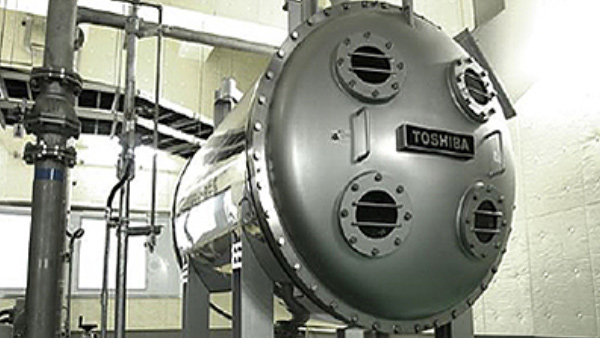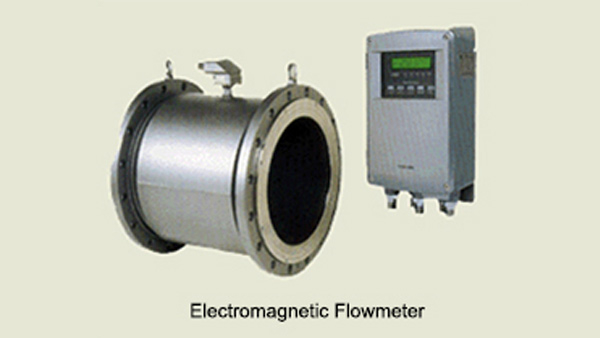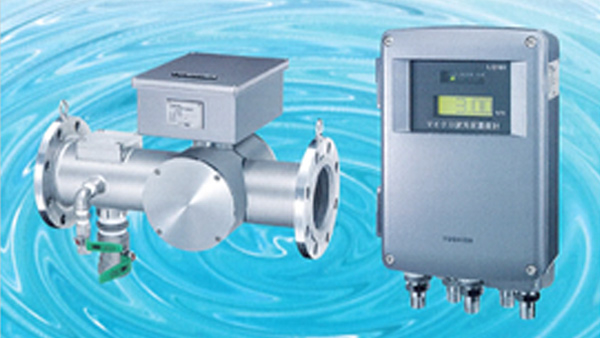Water Supply and Sewerage
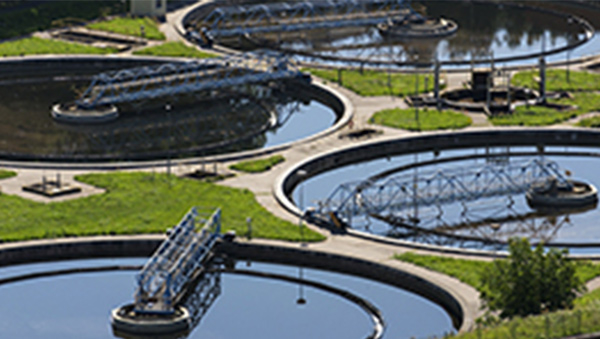
Overview
Water supply and sewerage infrastructure is essential to secure water supply by maintaining drinking water quality, preserving water quality at water sources and ensuring proper sewage treatment for protecting public health.
With technological expertise and know-how, we, Toshiba, supply highly reliable plants to maintain stable and efficient operations, as well as offer the best solution to improve the energy efficiency of the plant, streamline operations and provide new value to our clients.
SCADA
Water supply and sewerage systems must be properly managed and operated to ensure safe and secure lives.
SCADA(*1) is used to quickly and accurately identify the operational status of water supply and sewerage systems. Automatic control ensures smooth and smart operation of systems, making it easier to achieve the desired water quality and save energy.
Through external communication networks, SCADA allows a management center to keep track of systems, for example, for purification and sewage treatment, which are dispersed across the world. Therefore, it can be adapted to a wide range of applications, such as management of widely-spread plants and unattended operations, in a flexible way.
- (*1) SCADA: Supervisory Control and Data Acquisition
Overview
With our expertise and decades of experience in monitoring and control of water supply and sewage treatment plants, we offer operator-friendly systems. These systems help operators quickly and accurately monitor the real-time operating status of power receiving and transforming equipment, components, devices and instruments for water supply and sewerage.
Highlights
- We offer flexible systems that can be used for wide area monitoring.
- The client/server configuration can be integrated with different types and sizes of systems.
Configuration Example

Related Systems
- Ozone Injection Control System with Fluorescence Intensity
- Coagulant Injection Control System
- Water Distribution Management System
- Energy-efficient Aeration Air Flow Control System for Nitrogen Removal
Related Products
Ozone Injection Control System with Fluorescence Intensity
Rivers and lakes as water sources are facing water quality problems such as musty odors caused by algae and generation of THMs(*2). Water quality is degraded due to eutrophication, discharge of domestic wastewater and inflow of agricultural chemicals. The conventional way of disinfecting water by chlorination cannot address water quality degradation of water sources.
It is becoming an increasingly acute problem, especially musty odors in summer and ammonium nitrogen in winter.
- (*2) THMs: Trihalomethanes
Overview
When bromide ions are present, bromic acid as a drinking water quality standard item is produced due to excessive injection of ozone. Feedforward and feedback control based on fluorescence intensity of water adjusts the amount of ozone injected. This contributes to maintaining the safe water quality level (suppressing bromate formation) and energy-efficient operation (reducing energy for ozone generation).
Highlights
- Fluorescence intensity correlates strongly with THMs precursors, TOC(*3) and KMnO4(*4) consumption, as well as other organic indicators.
- Fluorescence intensity is an organic indicator, which is more sensitive than ultraviolet absorbance (E260) and less influenced by turbidity.
- Control based on fluorescence intensity allows the appropriate amount of ozone to be injected.
- (*3) TOC: Total Organic Carbon
- (*4) KMnO4: Potassium Permanganate
Configuration Example
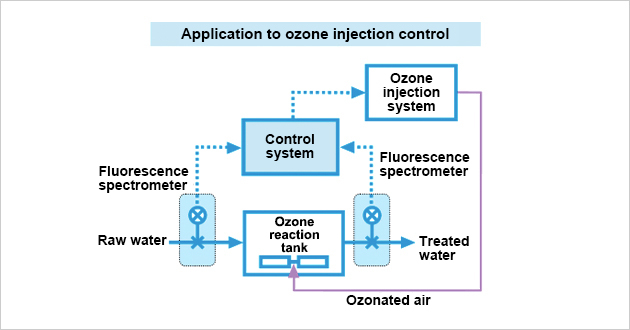
This system can also control powdered activated carbon injection.
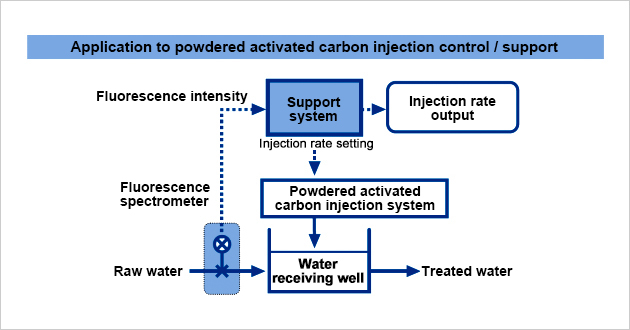
Related Systems
Related Products
Coagulant Injection Control System
The more the demand for higher drinking water quality increases, the more stringent water quality management at purification plants becomes to supply safe and good quality water. Under such circumstances, we have developed a feedback control system for coagulant injection. This system with a streaming current meter is applied to plants.
Overview
The conventional coagulant injection control system was equipped with feedforward control according to the raw water turbidity based on the previous injection results as well as the coagulant injection rate curve. However, it was unable to respond to rapid fluctuations in raw water quality thus tended to result in excessive coagulant injection to maintain coagulation. The current coagulant injection control system is equipped with feedback control based on the streaming current value correlated to the coagulation status, as well as feedforward control. Eventually, it achieves adequate injection control to reduce the amount of coagulant injected.
Highlights
- Improved coagulant injection control to suppress excessive injection can reduce coagulant consumption.
- Plant operation (coagulant injection) can be achieved without relying on operator experience.
- Both aluminum sulfate and PAC(*5) coagulants can be used.
- Feedback control can save jar testing labor and reduce operator workload.
- (*5) PAC: Polyaluminum Chloride
Configuration Example
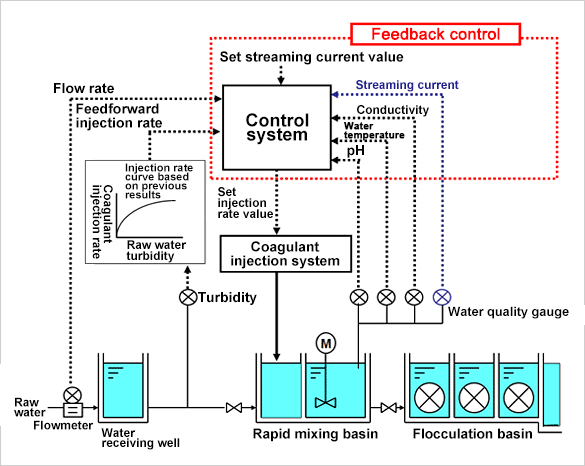

Related Systems
Water Distribution Management System
In recent years, the efficient use of water resources has gained recognition, along with stable water supply. Water supply facilities are reorganized, thus a wide range of water operations need to be planned.
Overview
For efficient operation of water distribution networks, our water distribution management system collects, accumulates and monitors measured values in real time, including fluctuating water distribution flow rates, pressures and water quality factors, and also alerts in the case of detecting any abnormal values. It enables quick decision-making in abnormal situations and reporting on operations such as analysis and implementation of measures.
Highlights
- Information necessary for water distribution management can be easily collected.
- Water distribution data can be managed periodically and thoroughly.
- Anomalies in distribution pipes can be quickly detected.
Configuration Example
- Trend data, including flow rates and pressure at measurement points in the water distribution area, are automatically collected through wide-ranging communication networks.
- Real-time automatic monitoring of collected and accumulated data is enabled on the screen, trend graph and record sheet.
- Prediction of potential leaks is enabled through analysis of accumulated data, along with detection of sudden leaks through analysis of trend data.

Related Systems
Related Products
Energy-efficient Aeration Air Flow Control System for Nitrogen Removal
In general, there is a trade-off relationship in sewage treatment between energy conservation and improvement in discharge water quality (reductions in nitrogen and phosphorus concentrations). In other words, more electrical energy is required to improve water quality while lower water quality is allowed to save energy. We have developed an energy-efficient aeration air flow control system, to increase energy conservation and improve discharge water quality, which are in a trade-off relationship.
Overview
The electricity cost required for aeration accounts for approx. 30 to 60% of the total electricity cost at the sewage treatment plant. Demands for control technologies are raised to save energy and reduce greenhouse gas (GHG) emissions, as well as to effectively remove nitrogen and phosphorus from treated water, which is discharged from sewage treatment plants, in order to prevent eutrophication in enclosed water areas. Our energy-efficient aeration air flow control system contributes to energy conservation by effectively removing nitrogen.
Highlights
- According to Toshiba's unique control target curve based on data measured by the on-line ammonium nitrogen concentration (NH4-N) meter and dissolved oxygen (DO) meter, aeration air flow control enables removal of nitrogen with appropriate air flow. If the blower is installed, whose reduced aeration air flow rate leads to lower power, electrical power and running costs may be significantly reduced.
- This control system is applicable to the treatment process (e.g. anaerobic - anoxic - aerobic process). For further information on anaerobic - aerobic and pseudo anaerobic - aerobic activated sludge processes, please contact us.
- The demonstration experiment proves that the aeration air flow in the reaction tank is reduced by approx. 10% compared to constant DO control.
Configuration Example

Related Systems
Global Network
With our expertise and rich experience in water and sewerage infrastructure development in Japan, we conduct business on a global scale.
We operate worldwide, and enhance capacity to provide the best solution to meet the needs of our clients.
We contribute to the creation of environmentally advanced communities with sustainable water infrastructure in response to regional, cultural and environmental requirements.




